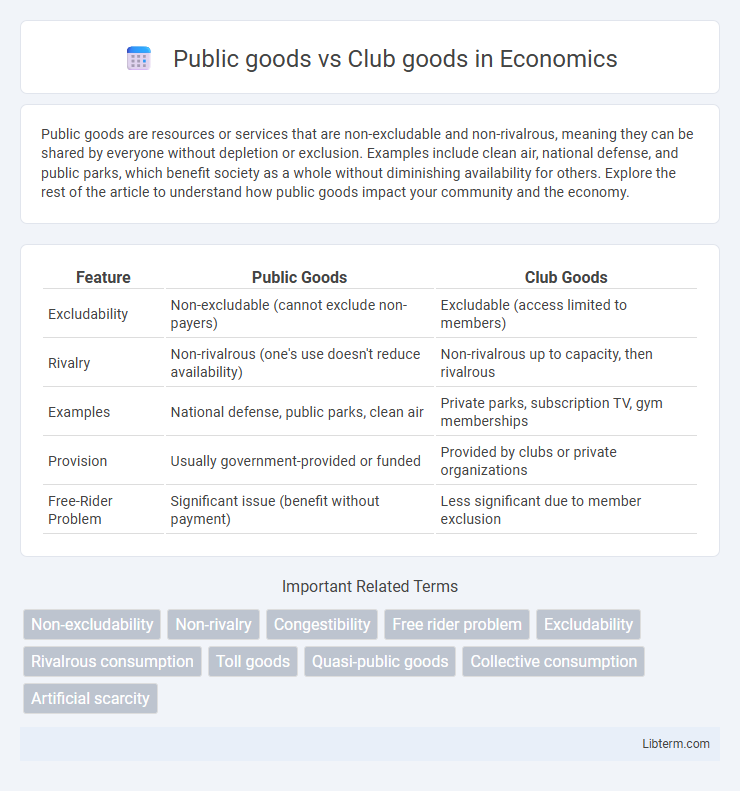Public goods are resources or services that are non-excludable and non-rivalrous, meaning they can be shared by everyone without depletion or exclusion. Examples include clean air, national defense, and public parks, which benefit society as a whole without diminishing availability for others. Explore the rest of the article to understand how public goods impact your community and the economy.
Table of Comparison
| Feature | Public Goods | Club Goods |
|---|---|---|
| Excludability | Non-excludable (cannot exclude non-payers) | Excludable (access limited to members) |
| Rivalry | Non-rivalrous (one's use doesn't reduce availability) | Non-rivalrous up to capacity, then rivalrous |
| Examples | National defense, public parks, clean air | Private parks, subscription TV, gym memberships |
| Provision | Usually government-provided or funded | Provided by clubs or private organizations |
| Free-Rider Problem | Significant issue (benefit without payment) | Less significant due to member exclusion |
Understanding Public Goods: Definition and Characteristics
Public goods are defined by their non-excludability and non-rivalrous consumption, meaning individuals cannot be effectively excluded from use, and one person's use does not reduce availability to others. Examples include national defense, clean air, and public broadcasting, which provide widespread benefits without diminishing access. These characteristics create challenges for private markets to supply public goods efficiently, often necessitating government intervention or collective funding.
What Are Club Goods? Key Features Explained
Club goods are non-rivalrous but excludable resources, meaning that consumption by one individual does not reduce availability to others within the club, yet access is restricted to members only. They exhibit key features such as congestion effects, where increased membership can lead to diminished enjoyment or utility, and the necessity of maintaining membership fees or criteria to manage access and funding. Common examples include private parks, subscription streaming services, and gym memberships, which balance shared use with controlled entry to optimize resource allocation and user experience.
Non-Rivalry and Non-Excludability: Core Concepts
Public goods are characterized by non-rivalry, meaning one person's consumption does not reduce availability for others, and non-excludability, where individuals cannot be effectively prevented from using the good. Club goods exhibit non-rivalry up to a certain capacity but are excludable, restricting access to members only. These core concepts differentiate public goods, like national defense, from club goods, such as private parks or subscription services.
Examples of Public Goods in Society
Public goods, characterized by non-excludability and non-rivalry, include examples such as national defense, public parks, and clean air, which benefit all members of society without diminishing availability for others. These goods contrast with club goods, like subscription-based streaming services or private golf clubs, where access is restricted and usage can be limited to paying members. Understanding public goods helps policymakers address free-rider problems and ensure equitable resource distribution.
Typical Club Goods: Real-World Instances
Typical club goods include private parks, subscription-based streaming services, and toll roads, characterized by excludability but non-rivalrous consumption up to capacity limits. These goods provide benefits exclusively to members who pay for access, contrasting with public goods, which are non-excludable and non-rivalrous. The management of club goods often involves regulating access to prevent congestion and maintain quality for members.
Provision and Funding Challenges
Public goods, characterized by non-excludability and non-rivalry, face significant provision challenges due to free-rider problems, making voluntary funding insufficient and often necessitating government intervention or taxation for sustainable financing. Club goods, which are excludable but non-rivalrous up to a congestion point, rely on membership fees or subscription models to fund provision, yet they must balance inclusivity with congestion costs to maintain service quality. Both types demand strategic mechanisms for efficient allocation and funding, with public goods requiring collective financing solutions and club goods managing membership incentives to optimize resource use.
Free Rider Problem in Public Goods
Public goods, characterized by non-excludability and non-rivalry, often suffer from the Free Rider Problem where individuals benefit without contributing to their provision, leading to underproduction. Club goods, in contrast, are excludable but non-rivalrous up to a point, allowing providers to manage access and reduce free riding by charging membership fees. The Free Rider Problem in public goods necessitates government intervention or collective funding mechanisms to ensure efficient resource allocation and sustained provision.
Access Control and Membership in Club Goods
Club goods feature restricted access controlled through membership criteria, ensuring only paying or qualified members benefit from the good, unlike public goods which are non-excludable and accessible to all. Access control in club goods prevents congestion and maintains quality, balancing exclusivity with shared use among members. Membership often involves fees or eligibility requirements that regulate participation and sustain club good provision.
Economic Implications: Efficiency and Equity
Public goods, characterized by non-excludability and non-rivalry, often lead to market failures due to free-rider problems, necessitating government intervention to ensure efficient provision and equitable access. Club goods, which are excludable but non-rivalrous up to a congestion point, allow for more efficient allocation through club membership fees or pricing, balancing exclusivity with shared benefits. The economic implications highlight that while public goods require collective financing to achieve equity, club goods enable targeted funding mechanisms that can improve efficiency but may raise equity concerns if access is restricted.
Policy Approaches to Managing Public and Club Goods
Policy approaches to managing public goods emphasize non-excludability and non-rivalry, focusing on government provision and funding through taxation to address free-rider problems and ensure optimal supply. In contrast, club goods management relies on exclusion mechanisms like membership fees or quotas, balancing supply to prevent congestion while maintaining exclusivity and efficient use. Regulatory frameworks and pricing strategies are crucial in both cases to align incentives, ensure sustainability, and maximize social welfare.
Public goods Infographic

 libterm.com
libterm.com